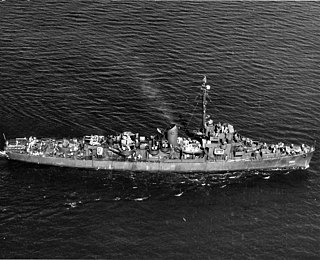
USS Lamberton (DD-119)/(DMS-2) was a Wickes-class destroyer in the United States Navy in commission from 1918 to 1922 and from 1930 to 1946. She saw service during World War II. She was the only ship named for Benjamin P. Lamberton, a rear admiral who served with Admiral Dewey in the Battle of Manila Bay in 1898 during the Spanish–American War.

USS Stribling (DD-96) was a Wickes-class destroyer in the United States Navy during World War I and the years following. She was the first ship named in honor of Cornelius Stribling.

The first USS Luce (DD-99) was a Wickes-class destroyer in the United States Navy during World War I and the years following. She was named in honor of Stephen B. Luce.

The first USS Maury (DD-100) was a Wickes-class destroyer in the United States Navy during World War I and the years following. She was named in honor of Matthew Fontaine Maury.

The first USS Lansdale (DD-101) was a Wickes-class destroyer in the United States Navy during World War I and later designated, DM-6 in the years following. She was named in honor of Philip Van Horne Lansdale.
USS Dallas (DD-199) was a Clemson-class destroyer in the United States Navy during World War II. She was the second ship named for Captain Alexander J. Dallas, and was later renamed Alexander Dallas.

USS Fox (DD-234/AG-85) was a Clemson-class destroyer in the United States Navy during World War II. She was the fourth ship named for Gustavus Vasa Fox, Assistant Secretary of the Navy during the Civil War.

The fourth USS Lawrence (DD-250) was a Clemson-class destroyer in the United States Navy during World War II. She was named for James Lawrence.

USS Edwards (DD-265) was a Clemson-class destroyer in the United States Navy and transferred to the Royal Navy where she served as HMS Buxton (H96) and later in the Royal Canadian Navy during World War II.

USS Isherwood (DD-284) was a Clemson-class destroyer in service with the United States Navy from 1919 to 1930. She was scrapped in 1931.

USS Carpellotti (APD-136) was a Crosley-class high speed transport in service with the United States Navy from 1945 to 1958. She was sold for scrap in 1966. Carpellotti was named after Marine Private First Class Louis J. Carpellotti (1918–1942), who was posthumously awarded the Silver Star for his actions on Tulagi, Solomon Islands, during the Battle of Guadalcanal.

USS John Willis (DE-1027) was a Dealey-class destroyer escort in the United States Navy in service from 1957 to 1972.

The third USS Lloyd Thomas (DD/DDE-764) was a Gearing-class destroyer in the United States Navy during the Korean War and the Vietnam War.

USS Trumpeter (DE-180) was a Cannon-class destroyer escort in service with the United States Navy from 1943 to 1947. She was sold for scrap in 1974.

USS Tomich (DE-242) was an Edsall-class destroyer escort in service with the United States Navy from 1943 to 1946. She was scrapped in 1974.

USS Howard D. Crow (DE-252) was an Edsall-class destroyer escort built for the U.S. Navy during World War II. She served in the Atlantic Ocean the Pacific Ocean and provided destroyer escort protection against submarine and air attack for Navy vessels and convoys.

USS Rhodes (DE-384) was an Edsall-class destroyer escort in service with the United States Navy from 1944 to 1946 and from 1955 to 1963. She was scrapped in 1975.

USS Janssen (DE-396) was an Edsall-class destroyer escort in service with the United States Navy from 1943 to 1946. She was sold for scrapping in 1973.

USS Woodson (DE-359) was a John C. Butler-class destroyer escort acquired by the United States Navy during World War II. The primary purpose of the destroyer escort was to escort and protect ships in convoy, in addition to other tasks as assigned, such as patrol or radar picket.

USS Ruchamkin (APD-89), ex-DE-228, later LPR-89, was a United States Navy high-speed transport in commission from 1945 to 1946, from 1951 to 1957, and from 1961 to 1969. She subsequently served as ARC Córdoba in the Colombian Navy, until 1980; although scrapped, her hull and superstructure were re-erected in a leisure park near Bogotá.



















